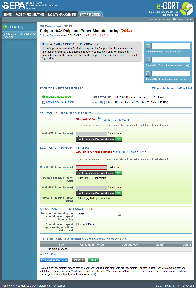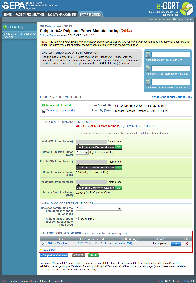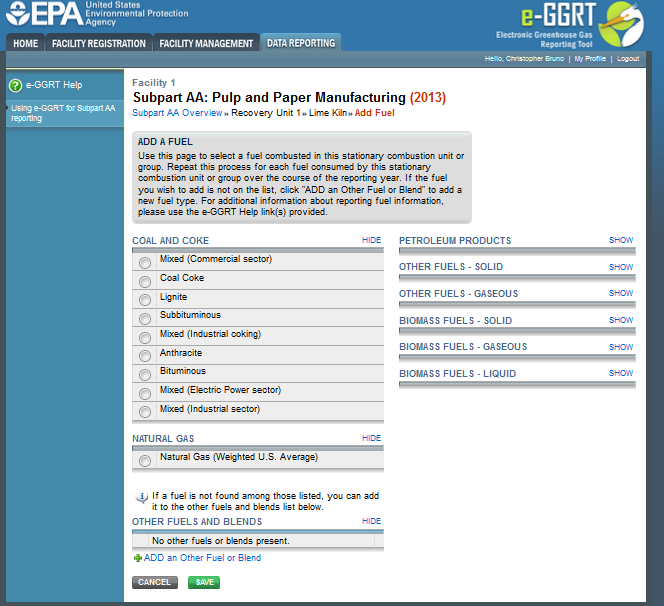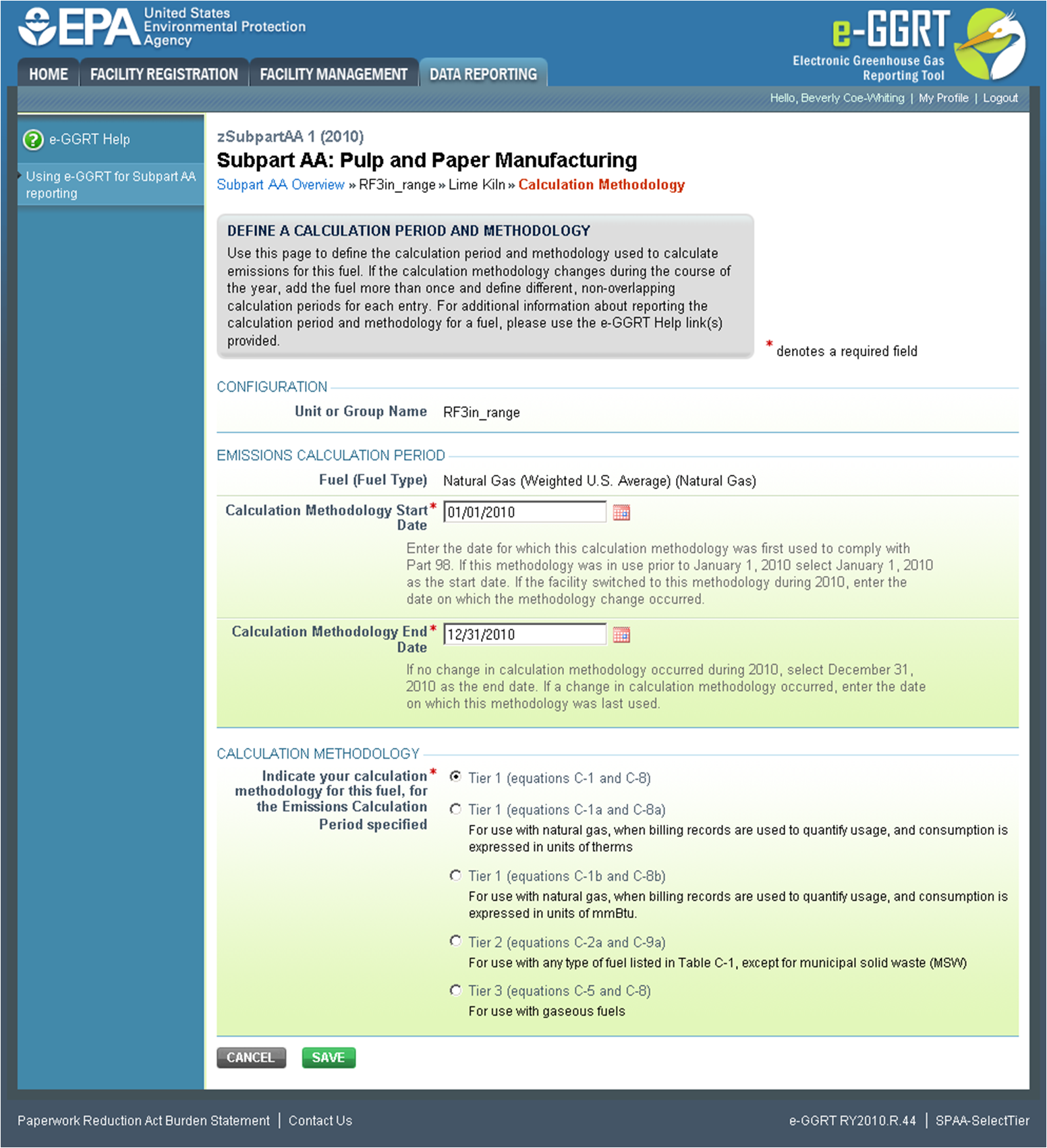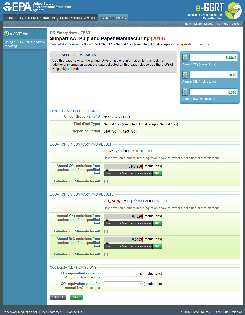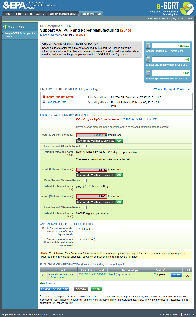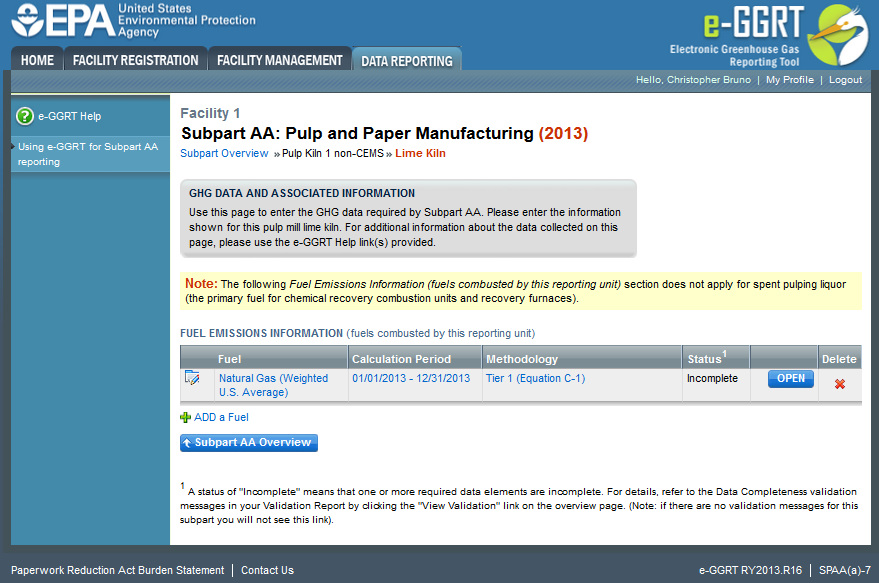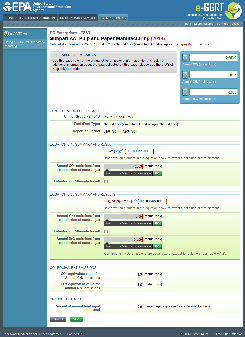This page provides a step-by-step description of how to enter Subpart AA emissions data.
Note: Emissions information for Subpart AA depends upon the type of unit.
- Chemical Recovery Furnace units require you to report emissions from spent liquor solids combustion using Equation AA-1, and emissions from fossil fuel combustion using Equations from Subpart C.
- Chemical Recovery Combustion Units require you to report emissions from spent liquor solids combustion using Equation AA-1 and AA-2, and emissions from fossil fuel combustion using Equations from Subpart C.
- Pulp Mill Lime Kilns require you to report emissions using Equations from Subpart C.
Adding or Updating Emissions Information for a Chemical Recovery Furnace or Combustion Unit
To add or update Subpart AA emissions information for a Chemical Recovery Furnace or Chemical Recovery Combustion Unit, find the unit or furnace for which you would like to enter emissions information in the UNIT AND FURNACE SUMMARY table on the Subpart AA Overview page, and click OPEN.
Click this link to expand
Step 1: Equations AA-1 / AA-2 Summary and Result
For each chemical recovery furnace, Subpart AA requires the following emissions information:
- The annual biogenic CO2, CH4 and N2O process emissions from spent liquor solids combustion
- CO2, CH4, and N2O emissions from supplemental fossil fuel combustion (see Step 3 below)
Calculate these values using the Inputs Verifier Tool (IVT), which is accessed from the EQUATION AA-1 SUMMARY AND RESULT section on the Equation AA-1 Summary page.
Click this link to expand
However, before you can access IVT, you must select the default emission factor for CO2 (in kg CO2 per mmBtu) used in Equation AA-1 from the Default Emission Factor dropdown located below the "Result (CO2) from biomass" data entry cell:
- 94.4
- 93.7
- 95.5
- 95.1
Immediately below the data entry cell labeled "Result CO2 from biomass" you will see a block labeled "Use Input Verifier to calculate" and a green "Go" box. Click "Go" to open the inputs verifier module for chemical recovery furnaces.
See Entering Emissions Information for Chemical Recovery Furnaces Using IVT for instructions for entering the required emissions data.
For each chemical recovery combustion unit, Subpart AA requires the following emissions information:
- The annual biogenic CO2, CH4, and N2O process emissions from spent liquor solids combustion
- CO2, CH4, and N2O emissions from supplemental fossil fuel combustion (see Step 3 below)
Calculate these values using the Inputs Verifier Tool (IVT), which is accessed from the EQUATION AA-2 SUMMARY AND RESULT section on the Equation AA-1 / AA-2 Summary page.
The Equation AA-1 / AA-2 Summary page is presented below. You can hover over an element in the equation to reveal a definition of that element.
Click this link to expand
Immediately below the data entry cell labeled "Result CO2 from biomass" you will see a block labeled "Use Inputs Verifier to calculate" and a green "Go" box. Click "Go" to open the inputs verifier module for chemical recovery combustion units.
See Entering Emissions Information for Chemical Recovery Combustion Units Using IVT for instructions for entering the required emissions data.
Step 2: Basis and Substitute Value
For each unit or furnace within your facility, Subpart AA requires you to report the following data:
- The basis for annual mass. Select from:
- TAPPI method
- On-line metering/measuring system
- Indicate if a substitute value was used.
Note: Steps 3-4 below apply for supplemental fuels only (such as natural gas or fuel oil). Steps 3-4 do not apply for emissions from spent pulping liquor which are entered under steps 1-2 above.
Step 3: Identify Supplemental Fuels Combusted by this Unit
To add a fuel combusted by this unit, click the link titled "ADD a Fuel" below the FUEL EMISSIONS INFORMATION table.
To edit a fuel, click on the Name/ID link, which is the first column in the FUEL EMISSIONS INFORMATION table.
To delete a fuel, click on the delete icon, which appears in the last column in the FUEL EMISSIONS INFORMATION table after a fuel is added.
Note: Although it is uncommon for a chemical recovery furnace or chemical recovery combustion unit to combust biomass fuels as supplemental fuels in place of fossil fuels such as natural gas or fuel oil, should any supplemental biomass fuels be combusted, emissions from these fuels may be added by following the procedures provided here in Steps 3 and 4 based on the Equations from subpart C.
Click this link to expand
On the Add Fuel screen, select a fuel combusted by this unit.
When finished, click SAVE.
Click this link to expand
For each fuel combusted by the unit, Subpart AA requires the following fuel information
- Calculation methodology start date and end date, for each fuel type
- Calculation methodology used for the emissions calculation period specified, for each fuel type:
- Tier 1/Equation C-1: Annual fuel combusted, default heating value, and default CO2 emission factor
- Tier 1/Equation C-1a: Annual natural gas usage from billing records (therms) and default CO2 emission factor
- Tier 1/Equation C-1b: Annual natural gas usage from billing records (mmBtu) and default CO2 emission factor
- Tier 2/Equation C-2a: Annual fuel combusted, measured heating value, and default CO2 emission factor
- Tier 2/Equation C-2c: Steam generation, ratio of maximum rated heat input capacity to design rated steam output capacity, and default CO2 emission factor (for MSW and solid fuels listed in Table C-1)
- Tier 3/Equation C-3: Annual mass of solid fuel combusted and average carbon content of the solid fuel
- Tier 3/Equation C-4: Annual mass of liquid fuel combusted and average carbon content of the liquid fuel
- Tier 3/Equation C-5: Annual volume of gaseous fuel combusted, average carbon content of the gaseous fuel, and average molecular weight of the gaseous fuel
When you have entered the required information, click SAVE.
Repeat this step until all fuels combusted by this unit have been added and identified.
Click this link to expand
Step 4: Calculate the Required Emissions Information for Each Fuel Using IVT (if applicable)
To access the IVT for each fuel, click on "Open" for the fuel for which you wish to enter information to open the Fuel-Specific Emissions page for that fuel. You will find a data entry cell for CO2 in the EQUATION SUMMARY AND RESULT section of the page. (The labels for this section identify the specific equation used to calculate emissions.) Immediately below this data entry cell you will see a block labeled "Use Input Verifier to calculate" and a green "Go" box. Click "Go" to open IVT module for the fuel.
See Entering Fuel-Specific Emissions Information Using IVT for instructions for using IVT to calculate fuel-specific emissions. The IVT module calculates the following emission quantities from the equation inputs entered depending on the methodology selected for the fuel:
Tier 1 - Chemical Recovery Furnace or Chemical Recovery Combustion Unit
For each fuel type (including any biomass fuel(s)) other than spent pulping liquor for which you have elected to use a Tier 1 (Equation C-1, C-1a, or C-1b) methodology, you are required to report the following information by fuel type:
- The total annual CO2 mass emissions derived from Equation C-1, Equation C-1a, or Equation C-1b in metric tons CO2 [98.36(b)(8)(i), 98.36(c)(1)(vi), 98.36(c)(3)(vii)]
- The total annual CH4 mass emissions derived from Equation C-8, Equation C-8a, or Equation C-8b in metric tons CH4 and in metric tons CO2e (for Table C-2 fuels only) [98.36(b)(8)(i), 98.36(c)(1)(vi), 98.36(c)(3)(vii)]
- The total annual N2O mass emissions derived from Equation C-8, Equation C-8a, or Equation C-8b in metric tons N2O and in metric tons CO2e (for Table C-2 fuels only) [98.36(b)(8)(i), 98.36(c)(1)(vi), 98.36(c)(3)(vii)]
Tier 2 - Chemical Recovery Furnace or Chemical Recovery Combustion Unit
For each fuel type (including any biomass fuel(s)) other than spent pulping liquor for which you have elected to use the Tier 2 (Equation C-2a) methodology, you are required to report the following information by fuel type:
- The total annual CO2 mass emissions derived from Equation C-2a in metric tons CO2 [98.36(b)(8)(i), 98.36(c)(1)(vi), 98.36(c)(3)(vii)]
- The total annual CH4 mass emissions derived from Equation C-9a in metric tons CH4 and in metric tons CO2e (for Table C-2 fuels only) [98.36(b)(8)(i), 98.36(c)(1)(vi), 98.36(c)(3)(vii)]
- The total annual N2O mass emissions derived from Equation C-9a in metric tons N2O and in metric tons CO2e (for Table C-2 fuels only) [98.36(b)(8)(i), 98.36(c)(1)(vi), 98.36(c)(3)(vii)]
- Identification of each month for which HHVs were calculated using one or more substitute data values [98.36(e)(2)(ii)(C)]
- The frequency of the HHV determinations [98.36(e)(2)(ii)(B)]
- Hourly
- Daily
- Weekly
- Monthly
- Semiannually
- Quarterly
- Once per fuel lot
- Upon addition of oil to the storage tank
- Other (specify)
For each fuel type (including any biomass fuel(s)) other than spent pulping liquor for which you have elected to use the Tier 2 (Equation C-2c) methodology, you are required to report the following information by fuel type:
- The total annual CO2 mass emissions derived from Equation C-2c in metric tons CO2 [98.36(b)(8)(i), 98.36(c)(1)(vi), 98.36(c)(3)(vii)]
- The total annual CH4 mass emissions derived from Equation C-9b in metric tons CH4 and in metric tons CO2e (for Table C-2 fuels only) [98.36(b)(8)(i), 98.36(c)(1)(vi), 98.36(c)(3)(vii)]
- The total annual N2O mass emissions derived from Equation C-9b in metric tons N2O and in metric tons CO2e (for Table C-2 fuels only) [98.36(b)(8)(i), 98.36(c)(1)(vi), 98.36(c)(3)(vii)]
Tier 3 - Chemical Recovery Furnace or Chemical Recovery Combustion Unit
For each fuel type (including any biomass fuel(s)) other than spent pulping liquor for which you have elected to use a Tier 3 (Equation C-3, C-4, or C-5) methodology, you are required to report the following information by fuel type:
- The total annual CO2 mass emissions derived from Equation C-3 for solid fuels, Equation C-4 for liquid fuels, or Equation C-5 for gaseous fuels in metric tons CO2 [98.36(b)(8)(i), 98.36(c)(1)(vi), 98.36(c)(3)(vii)]
- The total annual CH4 mass emissions derived from Equation C-8 in metric tons CH4 and in metric tons CO2e (for Table C-2 fuels only) [98.36(b)(8)(i), 98.36(c)(1)(vi), 98.36(c)(3)(vii)]
- The total annual N2O mass emissions derived from Equation C-8 in metric tons N2O and in metric tons CO2e (for Table C-2 fuels only) [98.36(b)(8)(i), 98.36(c)(1)(vi), 98.36(c)(3)(vii)]
- The total number of valid carbon content determinations [98.36(e)(2)(iv)(D)]
- The total number of carbon content substitute data values [98.36(e)(2)(iv)(E)]
- The frequency of carbon content determinations [98.36(e)(2)(iv)(B)]
- Hourly
- Daily
- Weekly
- Monthly
- Semiannually
- Quarterly
- Once per fuel lot
- Upon addition of oil to the storage tank
- Other (specify)
- The total number of operating hours in the reporting year for which missing data substitution was used for fuel usage [98.3(c)(8)]
For each gaseous fuel at each configuration for which you have elected to use the Tier 3 (Equation C-5) methodology, you are also required to report the following additional information:
- Total number of valid molecular weight determinations [98.36(e)(2)(iv)(D)]
- Total number of molecular weight substitute data values [98.36(e)(2)(iv)(E)]
- Frequency of molecular weight determinations [98.36(e)(2)(iv)(B)]
- Hourly
- Daily
- Weekly
- Monthly
- Semiannually
- Quarterly
- Other (specify)
When you have finished entering emission results for the unit, click SAVE.
Repeat this step until emissions information has been entered for each fuel combusted by the unit. The following screenshot provides one example of a fuel-specific emissions information page.
Click this link to expand
Step 5: Save Your Data
When you have finished entering emission results and substitute data, click SAVE.
After you save the data on this page, the next time you open the page, the calculator on the top of the page will display the CO2, CH4, and N2O process emissions, rounded to the nearest 0.1, 0.01, and 0.001 of a metric ton, respectively. The value displayed is for informational purposes only.
When CO2, CH4 and N2O process emissions have been entered the Status column on the Unit and Furnace Summary will show “Complete” and the background color for that furnace will show as green.
Adding or Updating Emissions for a Pulp Mill Lime Kiln
To add or update Subpart AA emissions for unit type Pulp Mill Lime Kiln, find the kiln or calciner for which you would like to enter emissions information in the UNIT AND FURNACE SUMMARY table on the Subpart AA Overview page, and click OPEN.
Click this link to expand
Step 1: Identify Fuels Combusted by this Unit
To add a fuel combusted by this unit, click the link titled "ADD a Fuel" below the FUEL EMISSIONS INFORMATION table.
To edit a fuel, click on the Name/ID link, which is the first column in the FUEL EMISSIONS INFORMATION table.
To delete a fuel, click on the delete icon, which appears in the last column in the FUEL EMISSIONS INFORMATION table after a fuel is added.
Click this link to expand
On the Add Fuel screen, select a fuel combusted by this unit.
When finished, click SAVE.
Click this link to expand
For each fuel combusted by the unit, Subpart AA requires the following fuel information:
- Calculation methodology start date and end date, for each fuel type
- Calculation methodology used for the emissions calculation period specified, for each fuel type:
- Tier 1/Equation C-1: Annual fuel combusted, default heating value, and default CO2 emission factor
- Tier 1/Equation C-1a: Annual natural gas usage from billing records (therms) and default CO2 emission factor
- Tier 1/Equation C-1b: Annual natural gas usage from billing records (mmBtu) and default CO2 emission factor
- Tier 2/Equation C-2a: Annual fuel combusted, measured heating value, and default CO2 emission factor
- Tier 2/Equation C-2c: Steam generation, ratio of maximum rated heat input capacity to design rated steam output capacity, and default CO2 emission factor (for MSW and solid fuels listed in Table C-1)
- Tier 3/Equation C-3: Annual mass of solid fuel combusted and average carbon content of the solid fuel
- Tier 3/Equation C-4: Annual mass of liquid fuel combusted and average carbon content of the liquid fuel
- Tier 3/Equation C-5: Annual volume of gaseous fuel combusted, average carbon content of the gaseous fuel, and average molecular weight of the gaseous fuel
When you have entered the required information, click SAVE.
Repeat this step until all fuels combusted by this unit have been added and identified.
Click this link to expand
Step 2: Enter Required Emissions Information for Each Fuel
Emissions from fuel combusted in a pulp mill lime kiln must be entered using IVT. To access the IVT from the GHG Data and Associated Information page, click on "Open" in the FUEL EMISSIONS INFORMATION table for the fuel for which you wish to enter information. This action opens the Fuel-Specific Emissions page for that fuel. You will find a data entry cell for CO2 in the EQUATION SUMMARY AND RESULT section of the page. (The labels for this section identify the specific equation used to calculate emissions.) Immediately below this data entry cell you will see a block labeled "Use Input Verifier to calculate" and a green "Go" box. Click "Go" to open IVT module for the fuel.
See Entering Fuel-Specific Emissions Information Using IVT for instructions for using IVT to calculate fuel-specific emissions. The IVT module calculates the following emission quantities from the equation inputs entered depending on the methodology selected for the fuel:
Tier 1 - Lime Kilns
For each fuel type for which you have elected to use a Tier 1 (Equation C-1, C-1a, or C-1b) methodology, you are required to report the following information by fuel type:
- The total annual CO2 mass emissions derived from Equation C-1, Equation C-1a, or Equation C-1b in metric tons CO2 [98.36(b)(8)(i), 98.36(c)(1)(vi), 98.36(c)(3)(vii)]
- The total annual CH4 mass emissions derived from Equation C-8, Equation C-8a, or Equation C-8b in metric tons CH4 and in metric tons CO2e (for Table AA-2 fuels only) [98.36(b)(8)(i), 98.36(c)(1)(vi), 98.36(c)(3)(vii), 98.273(c)(2)]
- The total annual N2O mass emissions derived from Equation C-8, Equation C-8a, or Equation C-8b in metric tons N2O and in metric tons CO2e (for Table AA-2 fuels only) [98.36(b)(8)(i), 98.36(c)(1)(vi), 98.36(c)(3)(vii), 98.273(c)(2)]
Tier 2 - Lime Kilns
For each fuel type for which you have elected to use the Tier 2 (Equation C-2a) methodology, you are required to report the following information by fuel type:
- The total annual CO2 mass emissions derived from Equation C-2a in metric tons CO2 [98.36(b)(8)(i), 98.36(c)(1)(vi), 98.36(c)(3)(vii)]
- The total annual CH4 mass emissions derived from Equation C-9a in metric tons CH4 and in metric tons CO2e (for Table AA-2 fuels only) [98.36(b)(8)(i), 98.36(c)(1)(vi), 98.36(c)(3)(vii), 98.273(c)(2)]
- The total annual N2O mass emissions derived from Equation C-9a in metric tons N2O and in metric tons CO2e (for Table AA-2 fuels only) [98.36(b)(8)(i), 98.36(c)(1)(vi), 98.36(c)(3)(vii), 98.273(c)(2)]
- Identification of each month for which HHVs were calculated using one or more substitute data values [98.36(e)(2)(ii)(C)]
- The frequency of the HHV determinations [98.36(e)(2)(ii)(B)]
- Hourly
- Daily
- Weekly
- Monthly
- Semiannually
- Quarterly
- Once per fuel lot
- Upon addition of oil to the storage tank
- Other (specify)
For each fuel type for which you have elected to use the Tier 2 (Equation C-2c) methodology, you are required to report the following information by fuel type:
- The total annual CO2 mass emissions derived from Equation C-2c in metric tons CO2 [98.36(b)(8)(i), 98.36(c)(1)(vi), 98.36(c)(3)(vii)]
- The total annual CH4 mass emissions derived from Equation C-9b in metric tons CH4 and in metric tons CO2e (for Table AA-2 fuels only) [98.36(b)(8)(i), 98.36(c)(1)(vi), 98.36(c)(3)(vii), 98.273(c)(2)]
- The total annual N2O mass emissions derived from Equation C-9b in metric tons N2O and in metric tons CO2e (for Table AA-2 fuels only) [98.36(b)(8)(i), 98.36(c)(1)(vi), 98.36(c)(3)(vii), 98.273(c)(2)]
Tier 3 - Lime Kilns
For each fuel type for which you have elected to use a Tier 3 (Equation C-3, C-4, or C-5) methodology, you are required to report the following information by fuel type:
- The total annual CO2 mass emissions derived from Equation C-3 for solid fuels, Equation C-4 for liquid fuels, or Equation C-5 for gaseous fuels in metric tons CO2 [98.36(b)(8)(i), 98.36(c)(1)(vi), 98.36(c)(3)(vii)]
- The total annual CH4 mass emissions derived from Equation C-8 in metric tons CH4 and in metric tons CO2e (for Table AA-2 fuels only) [98.36(b)(8)(i), 98.36(c)(1)(vi), 98.36(c)(3)(vii), 98.273(c)(2)]
- The total annual N2O mass emissions derived from Equation C-8 in metric tons N2O and in metric tons CO2e (for Table AA-2 fuels only) [98.36(b)(8)(i), 98.36(c)(1)(vi), 98.36(c)(3)(vii), 98.273(c)(2)]
- The total number of valid carbon content determinations [98.36(e)(2)(iv)(D)]
- The total number of carbon content substitute data values [98.36(e)(2)(iv)(E)]
- The frequency of carbon content determinations [98.36(e)(2)(iv)(B)]
- Hourly
- Daily
- Weekly
- Monthly
- Semiannually
- Quarterly
- Once per fuel lot
- Upon addition of oil to the storage tank
- Other (specify)
- The total number of operating hours in the reporting year for which missing data substitution was used for fuel usage [98.3(c)(8)]
For each gaseous fuel at each configuration for which you have elected to use the Tier 3 (Equation C-5) methodology, you are also required to report the following additional information:
- Total number of valid molecular weight determinations [98.36(e)(2)(iv)(D)]
- Total number of molecular weight substitute data values [98.36(e)(2)(iv)(E)]
- Frequency of molecular weight determinations [98.36(e)(2)(iv)(B)]
- Hourly
- Daily
- Weekly
- Monthly
- Semiannually
- Quarterly
- Other (specify)
When you have finished entering equation inputs for the unit in the IVT module, click SAVE to return to the Fuel-specific Emissions page..
Repeat this step until emissions information has been entered for each fuel combusted by the unit. The following screenshot provides one example of a fuel-specific emissions information page.
Click this link to expand
Step 3: Save Your Data
Once you have entered emissions information for all fuels combusted by the unit, click Subpart AA Overview.
After you save the data on this page, the next time you open the page, the calculator on the top of the page will display the CO2, CH4, and N2O process emissions, rounded to the nearest 0.1, 0.01, and 0.001 of a metric ton, respectively. The value displayed is for informational purposes only.
When CO2, CH4 and N2O process emissions have been entered the Status column on the Unit and Furnace Summary will show “Complete” and the background color for that furnace will show as green.
See Also
Screen Errors
Using e-GGRT to Prepare Your Subpart AA Report for RY2014 and Later
Subpart AA Emissions Information for Units NOT Monitored By CEMS for RY2014 and Later
Subpart AA Emissions Information for Units NOT Monitored By CEMS for RY2014 and Later
Subpart AA Process Unit Information for Units NOT Monitored by CEMS for All Reporting Years
Subpart AA Process Unit Information for Units Monitored by CEMS for All Reporting Years
Subpart AA Emissions Information for Makeup Chemical Usage for RY2014 and Later
Subpart AA Emissions Information for Units NOT Monitored CEMS for RY2014 and Later
Entering Emissions Information for Chemical Recovery Furnaces Using IVT
Entering Emissions Information for Chemical Recovery Combustion Units Using IVT
Entering Fuel-Specific Emissions Using IVT
Subpart AA Emissions Information for Units Monitored by CEMS for All Reporting Years
Subpart Validation Report



